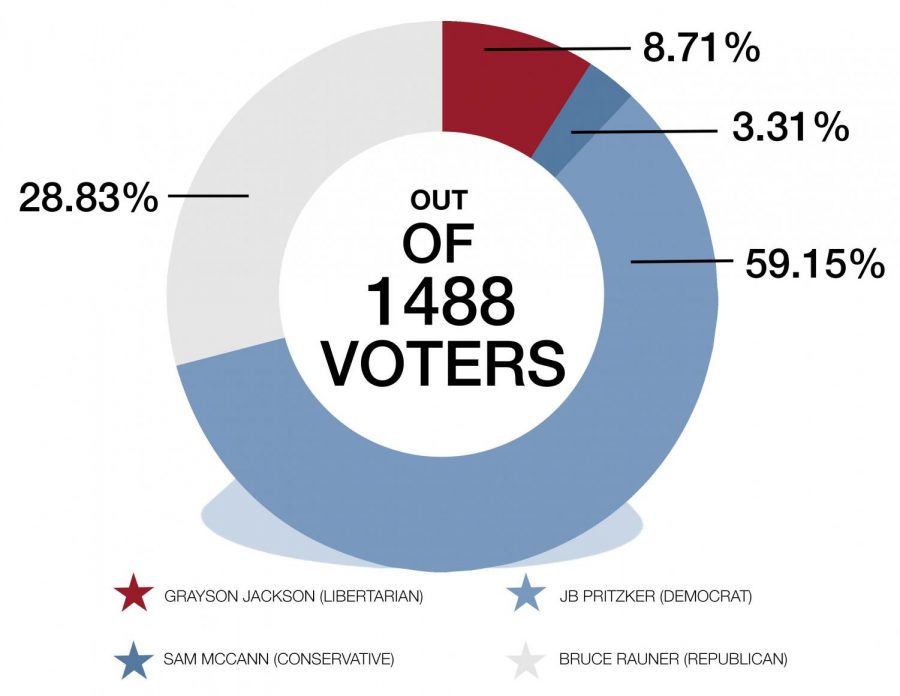Mock election mirrors recent midterm results
Record-breaking national turnout flips House to democrats
Last month’s midterm elections were defined by significant voter turnout and a democratic wave. These results were supported by the student mock election that Student Alliance held over Nov. 5 and 6.
In this area, votes swung democratic as they consistently do.
The poll received 4,046, responses from 1,154 students, about 28.5 percent of the student body, according to Student Alliance President Bill Yen.
According to the Chicago Tribune, the midterms brought the highest number of Chicago voters to the polls in 32 years, reaching 55.6 percent.
Junior Katherine Figura said for this midterm election, she started noticing a lot more.
“There was an emphasis on every available body going out to vote in light of the recent events in politics and the increasingly controversial decisions being made,” said Figura.
As a result of movements against voter suppression and increased political engagement, national voter turnout was much higher this year than in previous midterm elections. This made some races closer than expected.
In Texas, Beto O’Rourke gave Ted Cruz a run for his money in Texas, and in Florida, the Senate race is headed for a recount, according to the New York Times.
The number of votes cast in the 2018 midterms resembled the latest presidential election more closely than the last midterms. Of the population eligible to vote, about 48 percent cast votes for a total of 113 million votes as of Nov. 9, said the New York Times.
In Mississippi, republican Cindy Hyde-Smith and democrat Mike Espy qualified for a runoff election Nov. 27, since none of the original candidates reached a 50 percent consensus in the state’s primary election.
Nationally, the midterm elections yielded a republican senate and a democratic house, dividing congress between the two parties.
At the end of the election, democrats gained 32 net seats in the house and the republicans gained one seat in the senate.
Junior Megan Thomas said, “I’m glad the democrats have more representation in the house, because they seem to be the party pushing for laws that have an impact on students.
“Like gun reform,” Thomas elaborated, “With the recent school shootings, gun control would increase the sense of safety we feel at school. It should be interesting to see what happens in the following months.”
The breakdown of NT student voters included 244 freshman, 359 sophomores, 302 juniors, and 249 seniors.
While seniors are the only class which typically includes students who are eligible to vote, sophomores submitted the most votes.
Junior Madison Fisher believes this may be due to the new civics requirement. Researching the politics behind a controversial issue for a project in her civics class, “helped my understanding of the structure of government,” and “learn about things I didn’t think about before,” said Fisher.
Figura summarized, “While I’m not old enough to vote yet, it definitely sets up an environment where more people my age are exposed to the idea of voting and having a say in what’s occurring in politics today.”
While the majority of students still can’t vote, the mock election results correlated with the official Illinois results.
With 703 votes, 61.88 percent of NT students voted for attorney general Kwame Raoul. In the state midterms, Raoul won with 54.3 percent of votes.
Raoul campaigned on his intention to check the power of the Trump administration as a democrat and also to encourage bipartisan law reform, according to the Chicago Tribune.
In the elections for both governor and attorney general, the state of Illinois voted primarily republican; however, the areas with higher populations of voters contributed to the democratic victories.
JB Pritzker won the governorship with 54.2 percent of Illinois votes. Though the majority of counties in the state voted republican, Cook County, one of the largest voting populations (and where Pritzker is from), voted blue.
The Student Alliance poll indicated a 59.15 percent majority in Pritzker’s favor.
Senior Jackson Miller expressed his lack of surprise when Pritzker beat Rauner in the governor race.
“It seems like things pretty much went how everybody was expecting: Dems retaking the house, losing a few seats in the senate, and our area being fairly blue,” Miller said.
Pritzker’s platform includes increasing minimum wage, improving accessible healthcare, and graduated income tax, a system based on a bracket of income levels with specific rates to be determined.
Senior Will Thornton, “a democrat through and through,” said that while he supports the party, “He has not given any indication of what his graduated income tax would look like, and hasn’t laid any groundwork for how he will implement his goal of a $15 an hour minimum wage. He also has given no real plan of action for how he wants to get Illinois residents the chance to opt into a medicare program.”
Thornton explained that Pritzker “has the potential to do great things, he just needs to prove that he is willing to take the promises that won him the election and translate them into workable policy programs.”
The mock election poll collected 69.54 percent of votes for Brad Schneider. In the real election for the tenth congressional district, Schneider won 65.4 percent of votes.
In the ninth congressional district, Jan Schakowsky was expected to hold her democratic seat, and led with 77,292 district votes, totaling 84.5 percent. This was even more significant than her 71.79 percent total in the mock election.
Nationally, the midterms resulted in greater diversity of elected leaders.
Several candidates across the country made history, including Ayanna Pressley as the first African-American woman in Congress from MA; Ilhan Omar of MN and Rashida Tlaib of MI as the first Muslim women in Congress; Jared Polis of CO as the first openly gay governor; and Sharice Davids of KS and Deb Haaland of NM as the first Native American women in the House.






































